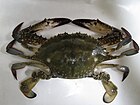Crabbing
|
|
Crab fisheries are fisheries which capture or farm crabs. True crabs make up 20% of all crustaceans caught and farmed worldwide, with about 1.4 million tonnes being consumed annually. The horse crab, Portunus trituberculatus accounts for one quarter of that total. Other important species include flower crabs (Portunus pelagicus), snow crabs (Chionoecetes), blue crabs (Callinectes sapidus), edible or brown crabs (Cancer pagurus), Dungeness crab (Metacarcinus magister) and mud crabs (Scylla serrata), each of which provides more than 20,000 tonnes annually.
The FAO groups fishery catches using the ISSCAAP classification (International Standard Statistical Classification of Aquatic Animals and Plants). ISSCAAP has a group for crabs and sea-spiders, and another group for king crabs and squat lobsters.
The following table summarises crab production from 2000 to 2008, both caught wild and from aquaculture, in tonnes.
Horse crabs are found from Hokkaidō to South India, throughout Maritime Southeast Asia and south to Australia. In Malay, it is known as ketam bunga or "flower crab". It lives on shallow sandy or muddy bottoms, less than 50 m deep, where it feeds on seaweeds and predates upon small fish, worms and bivalves. The carapace may reach 15 cm (5.9 in) wide, and 7 cm (2 3⁄4 in) from front to back.
...
Wikipedia

